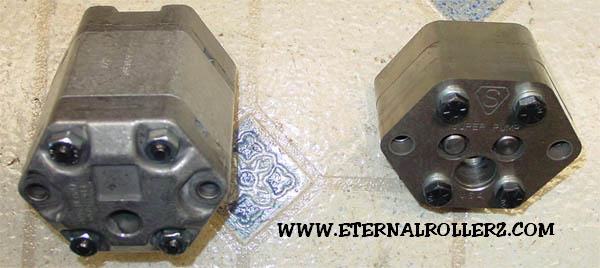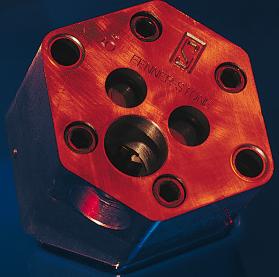
Pump Heads
The pump head is one of the most important parts of the hydraulic pump. It takes oil from the hydraulic reservoir and pumps it into the lines creating pressure. The method of pumping the hydraulic fluid is almost the same in all brands of pump heads. The oil is sucked into the inlet where two gears spin in a chamber and create pressure. One gear is shaft driven by a DC motor on the pump and the other gear is a idler gear. Pump heads are sold by different sizes that pump different amount of hydraulic fluid. A common modification to Fenner style pump heads is to enlarge the inlets and outlets.
Jason S.: The pump head can make or break your system. I highly recommend the Marzocchi pump heads. The #9 pump head is crazy good. That is what is in 3 of the Eternal Rollerz cars. IF YOUR SETUP HAS OTHER PUMP HEADS, CHANGE THEM!!! You won't be sorry about it. Putting 100 PSI in your tank will aid the pump in doing its work.
Jay S.: I do not agree with Jason, I have had very good luck with PN-206 Fenner pump heads. The Fenner pump heads are made from steel not aluminum. Steel is much stronger than aluminum, making Fenner pump heads more durable. My car hops pretty good with Fenner heads. Fenner style pump heads don't ever need to be rebuilt.
Make sure you visit out Fenner vs Marzocchi page and explore both sides of the heated debate.
Common Problems with Pump heads
Steel seal leaking - A tell tale sign of this condition is oil in your DC motors. If this is the case the seal can be replaced for about $10 and is easy to replace. This condition normally happens in older setups and can cause DC motor failure.
Pressure O-ring leaking - This condition can be tricky to figure out. You will notice that the pump doesn't put out much pressure or as much as it may have. This tends to happen after hopping the car sometimes. After using the pump open up the fluid tank and look for foam on the surface of the fluid. The foam is cause by pressure escaping from the O-ring and going back into the tank from in between the pump head and the manifold block.
Mechanical Failure - This is the most easy to figure out of all the problems a pump head can have. In most cases the coupler or pump head gears will break and you will hear the DC motor spinning free and not lifting the car. This is often caused by " dead heading " the pump. That is when the hydraulics are used and the system will not travel any more in the suspension. The pump head will need to be replaced.

Above: A Marzocchi pump head on the left and a Fenner copy on the right.
Above: Inlet side of a Fenner pump head on the left and a Fenner copy on the right.
Above: Outlet side of a Fenner pump head on the left and a Fenner copy on the right.
Above: A quick overview of what happened to Fenner and their name changes.

Above: A Fenner Stone PN-206 ported inlets and outlets from Porky's Hydraulics.
Above: A Fenner style pump head diagram showing gear rotation and fluid path.
Above: A Fenner style pump head with the Inlet plate removed. ( Note the enlarged outlet. )
Above: A Fenner copy pump head taken apart. ( Note the enlarged inlet. )
Above: Marzocchi pump heads spec sheet.
Above: Marzocchi pump head ready to be taken apart.
Above: Marzocchi pump head with the inlet plate removed.
Above: Marzocchi pump head with the inlet and outlet plates removed.
Above: Marzocchi pump head center clover leaf and gears. Note that the gears are put in as a unit into the center clover leaf.
Above: Here is one of two gear retainers that use friction bearings. Note the passage way for oiling the gear shafts.
Above: The center clover leaf with the inlet opened up on a drill for better flow. Make sure to polish the drilled metal with a rotary tool to remove burs and other restrictions. DO NOT DAMAGE THE WALLS OF THE CENTER CLOVER LEAF!!!!!
Above: The outlet plate has been ported out at an angle for better flow with a drill. Make sure to polish the drilled metal with a rotary tool to remove burs and other restrictions.
Changing Pump Heads ( Fenner )
Above: Oil was leaking inside the DC motor as you can see and smoking when the motor was used. The steel pump head seal was worn out and needed to be replaced.
Above: The DC motor is removed from the pump by taking off the rear motor plate and hold the armature shaft and pull the motor from the block. Never pull the motor off by the stator because the armature will stay on the block and putting the brushes back in place is no picnic. Don't lose the coupler when the motor is off.
Above: The pump is put on end to avoid losing fluids and to make taking the tank off easier.
Above: The tank pressure plate and rods are removed so we can now open the tank. Carefully hold the tank and slowly rock the manifold block until it comes apart. NEVER use a screw driver to pry the tank off.
Above: Normally two bolts hold in the pump head. Undo the bolts and wiggle the pump head from the block. If it won't come off he block a rubber mallet works great. Check the pressure outlet O-ring if it has any pinched parts or is frayed replace it. In this case a new pump head was put on the block. Our special " additive " was put inside the pump head to help on the breaking in period. New pump heads come with a steel seal already on them. The hydraulic fluid should be changed to new fluid and the empty tank should be cleaned out to get rid of any metal debris. The pump is assembled in reverse order of taking it apart.
Changing Pump Heads ( Marzocchi )
Above: Here is a block ready for the Marzocchi pump to bolt on. We are showing it from this point because we assume that you understand how to take the old one off.
Above: Here Mario carefully lines up the mounting holes and makes sure the pressure o-ring is in the correct place. Then the pump head is evenly torqued down.
Above: The pump head should be snug against the block.
Above: Mario puts the pump back together.
Above: Mario
puts the pump in the car again and tests the pump out.
All Photographs and Art Copyright
© 1998-2005 Eternal Rollerz C.C.
Website Design Copyright © 1998-2005 Webmaster